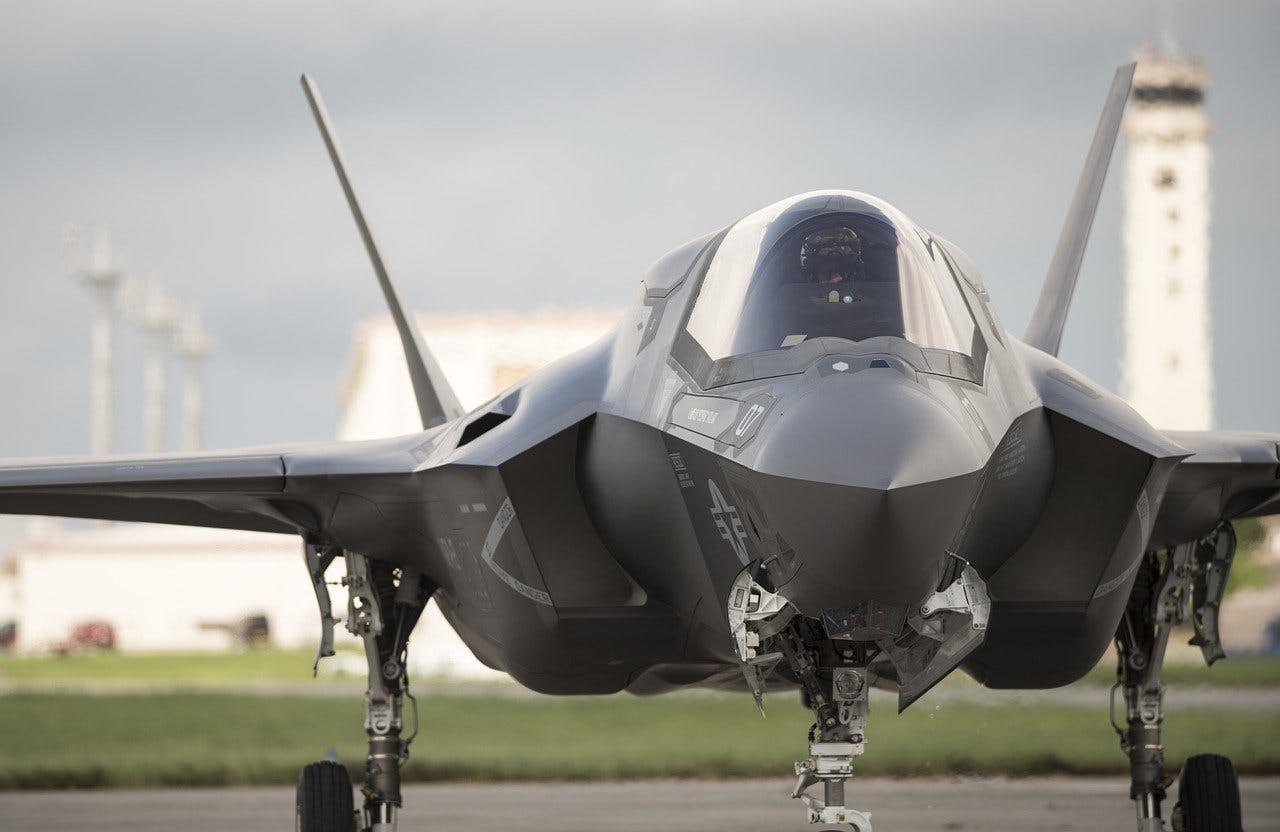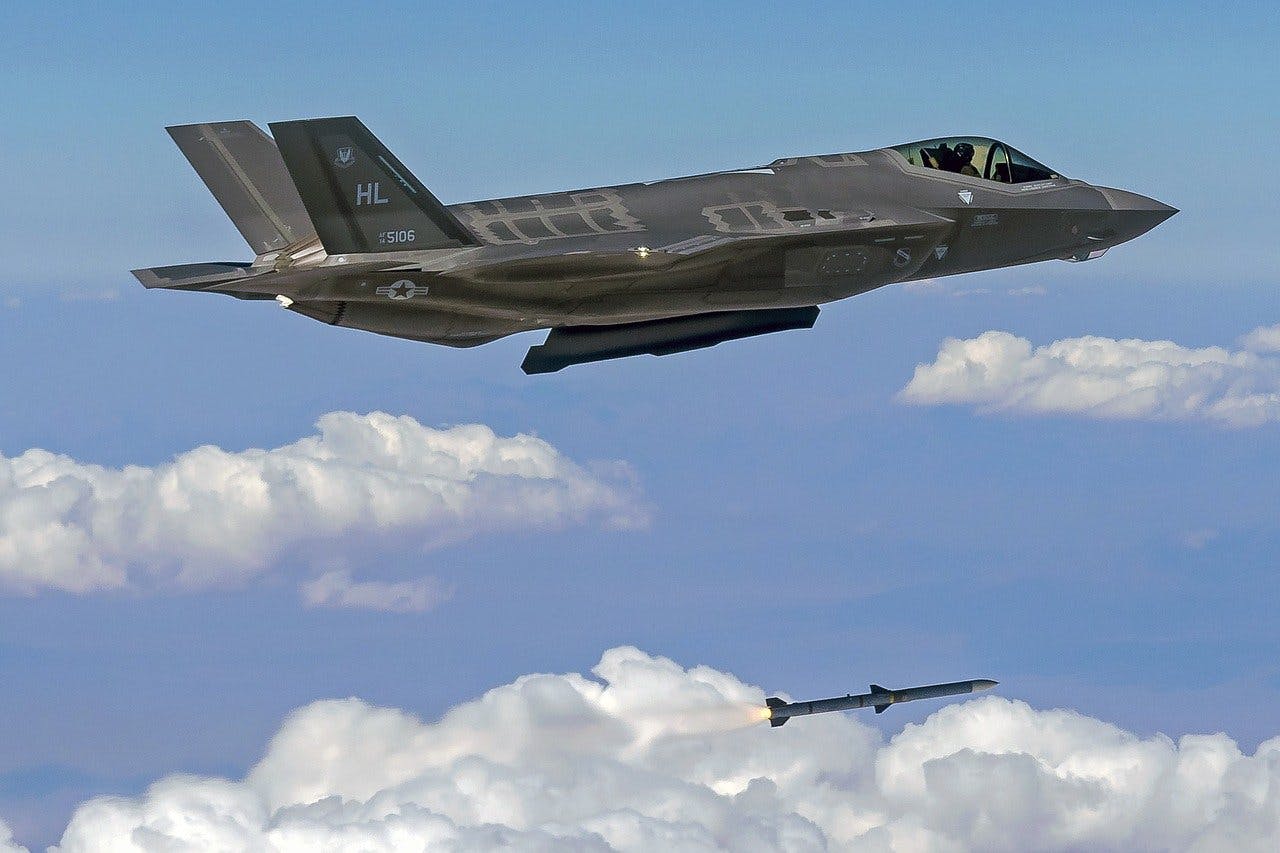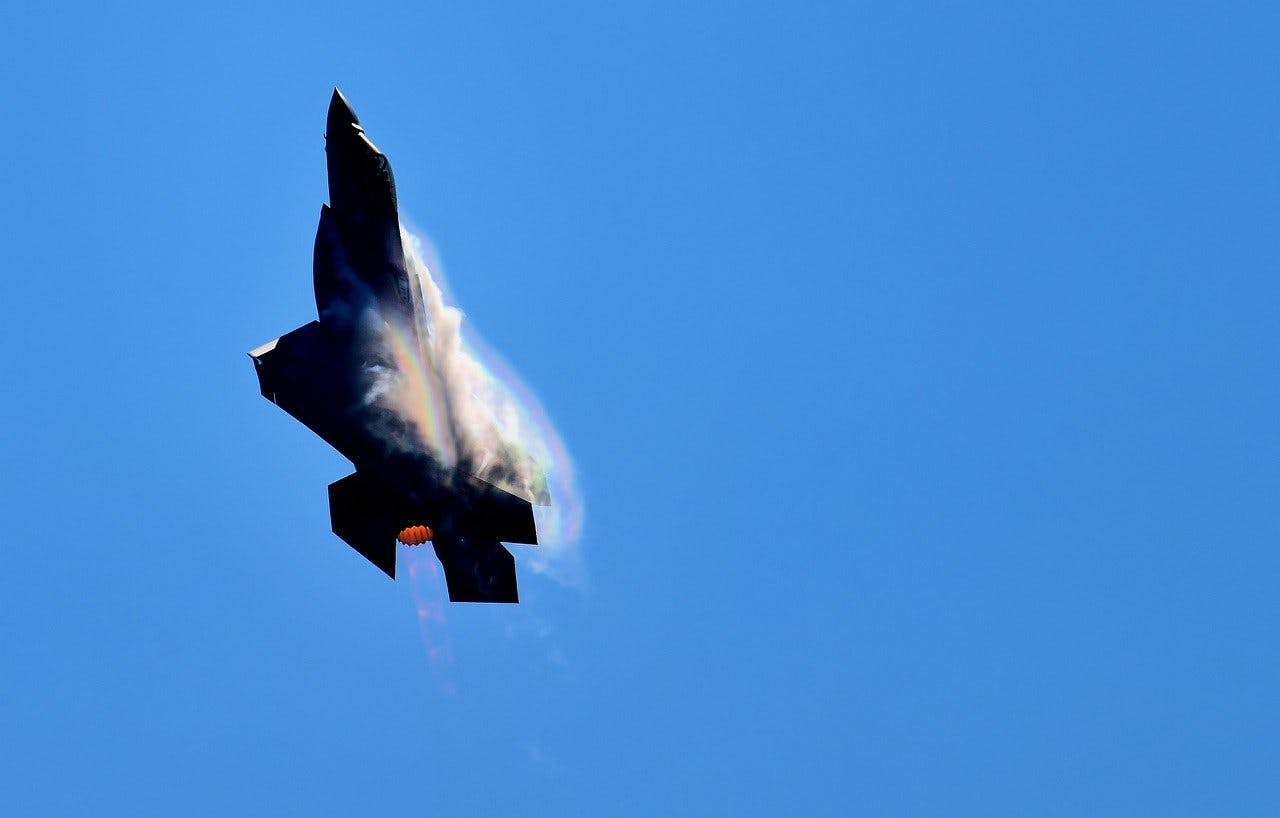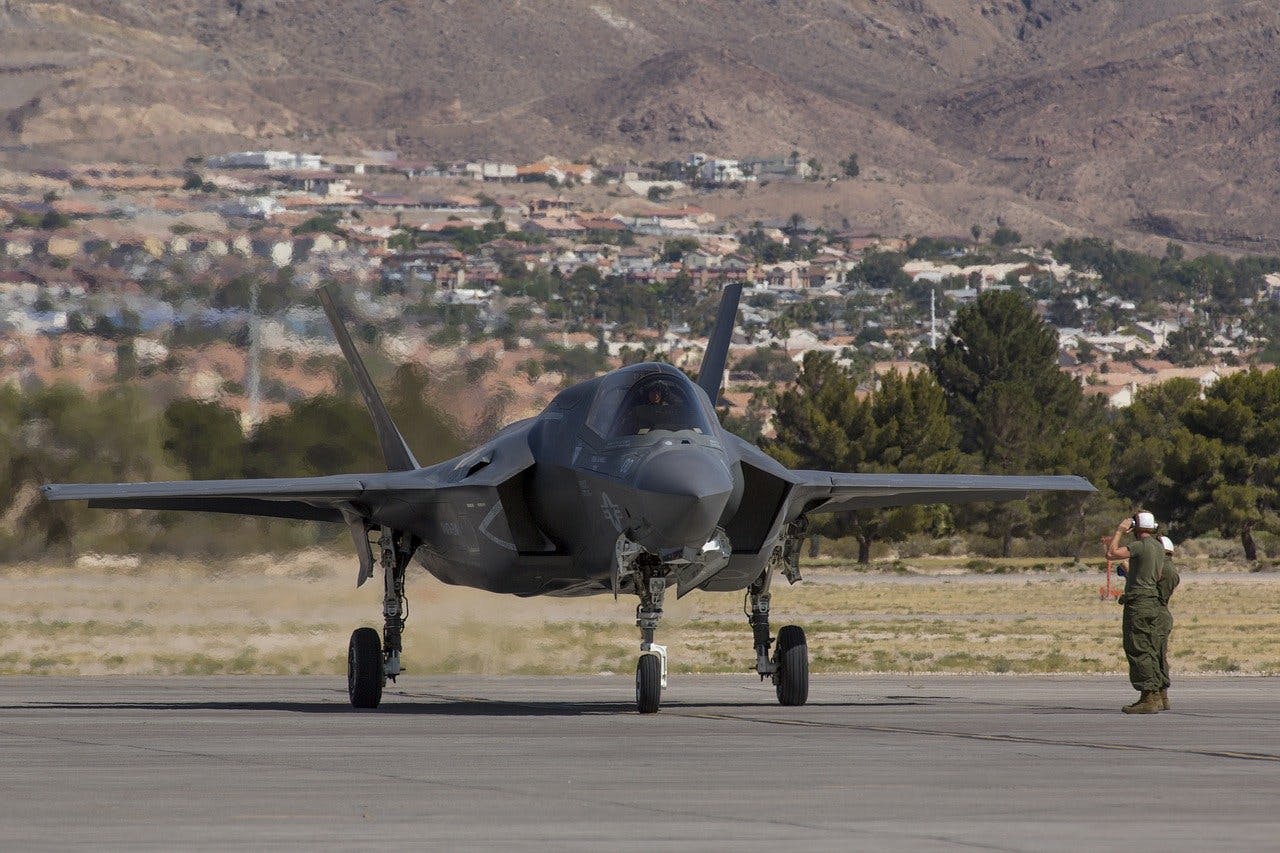Here’s your ultimate guide to the Joint Strike Fighter (JSF) program and the F-35

Blog
If you’re a hot-blooded American, you’ve probably had at least one moment in your life when you thought, “Ugh, I wish I knew more about the Joint Strike Fighter program!” Worry not, true American friends. We’ve got you fully covered in our ultimate guide.
What is the Joint Strike Fighter program (JSF)?
The Joint Strike Fighter (JSF) program is quite simply the largest design, development, and acquisition program in the history of the U.S. Department of Defense (DoD). The resulting F-35 Lightning II multirole fighter jet is one of the most versatile and capable aircraft in history, and is the most expensive weapons system ever built.
In an era where such initiatives can run into the hundreds of billions, or even trillions of dollars, that’s really saying something.
As often happens in military procurement programs/studies, the JSF program resulted from the merger of previous endeavors, the Common Affordable Lightweight Fighter (CALF) and Joint Advanced Strike Technology (JAST) projects. Both of these projects were intended to result in an aircraft that would replace the F-16 (and be affordable for all parties concerned).
However, one of the reasons the JSF program has become so huge (and so expensive) is because, as the CALF and JAST programs merged and more countries became involved, including NATO and other US allies, the JSF concept became extremely aggressive in its intent.
The new JSF aircraft was now intended to replace not only the F-16 Fighting Falcon, but multiple attack, interceptor, electronic warfare, and fighter/bomber aircraft fielded by the U.S. and its allies, including the A-10 “Warthog,” the F/A-18 Hornet variants A-D, the EA-6B Prowler, and the Tornado, in addition to both the U.S. and British versions of the famed Harrier (originally termed the “jump jet”).
The JAST/JSF program began in 1993, and after multiple companies submitted prototype designs and concepts, two were chosen for the final competition, the Boeing X-32, and Lockheed Martin’s X-35. After a lengthy and thorough evaluation, in October 2001 the X-35 was chosen as the winner and Lockheed Martin was awarded what PBS’s NOVA called “The most lucrative contract in military history: at least $200 billion.”

The (seemingly) impossible requirements of the Joint Strike Fighter
With so many cooks in the military kitchen, it’s understandable that the JSF program got a bit ambitious. A documentary on the JSF competition sums up the crux of the biscuit this way: “And the winner won’t be just any fighter. It will need to land on a carrier, evade enemy radar, and hover like a helicopter. But trying to build a fighter that can do all three is a tremendous challenge.”
Military.com reports, “The requirements for the Joint Strike Fighter are complex – from the start it must reach new heights of lethality, but be affordable. It must be survivable during the rigors of combat and supportable from austere environments. All the while, the F-35 JSF must meet all of these diverse needs of multiple services and still be affordable.”
As we will see, “affordable” is a relative term.
JSF STOVL vs. CTOL, and what military branch requested the F-35?
The STOVL (short take-off, vertical landing) requirement (the “hover like a helicopter” bit mentioned above) of the JSF is the sticky wicket. It turns out that after 20+ years and a growing expenditure of $400+ billion, when it comes down to it, the military has determined that there’s still a need for several very different variants of the F-35, rather than “a fighter that can do all three.”
The diverse requirements of the JSF program bring to mind the saying “you want it good, fast, and cheap? Pick two.” In other words, it turns out you have to choose what capabilities are most important to you:
- you can have the Navy’s F-35C variant with much greater wing area, uprated landing gear, an arresting hook, and folding wingtips to facilitate shipboard storage, capable of carrier operations and evading enemy radar (but doesn’t hover or STOVL); or
- you can have the Marines’ STOVL-capable variant (F-35B) that is capable of evading enemy radar (but isn’t optimized for carrier ops) and has limited range (the STOVL F-35B variant gives up a third of its fuel capacity to allow for the lift fan, ducting, and fairing) and dogfighting capabilities (the STOVL F-35B limits at 7 Gs, and the carrier variant at 7.5); or
- you can have the Air Force’s cheaper, simpler, longer-range CTOL (conventional take-off and landing) F-35A variant capable of pulling 9 Gs like the F-16 and evading enemy radar, though it can’t land on carriers nor is it capable of STOVL…
But you can’t have “a fighter that can do all three.” Yet.
So, as some people have pointed out, when you try to make a jet fighter do everything, it may not be the best at anything.
Don’t get us wrong… the F-35 is cool. Really frickin’ cool. Like, Fonzie jumping his motorcycle over James Dean and Miles Davis riding in an AC Cobra cool.
But you can’t talk about the JSF and the F-35 without talking about the big, stanky elephant in the room: the price.

What is the budget for the JSF F-35 program, and how much does an F-35 cost?
The U.S. Government Accountability Office reported the yearly projected average cost of the JSF program to be $12.5 billion with an estimated program life-cycle cost of $1.1 trillion.
Watchdog groups report an even larger total expenditure for the JSF program: “When all the operating costs for the planned fleet are calculated across the program’s expected 50-year lifetime, the American people will spend an estimated $1.727 trillion.” Not exactly chump change.
While the F-16 currently costs around $30 million per plane, and an A-10 Warthog used to cost about $18.8 million (around $46 million in today’s dollars) per plane, the Air Force’s F-35A costs $110 million, the Marine Corps’ F-35B costs $135.8 million, and the Navy’s F-35C costs $117.3 million per copy when all the relevant associated costs are factored in (per pogo.org).
Of course, with billions in juicy defense contracts on the line and budget numbers being bandied about by fans and detractors alike, getting accurate figures is difficult at best and impossible at worst.
In 2020 NBC News reported, “With an estimated lifetime cost of $1.6 trillion, the F-35 Lightning II, conceived as a versatile, super stealthy next-generation fighter plane, is the most expensive weapon system ever built. When the program began way back in 1992, the F-35 was supposed to be an affordable one-size-fits-all solution for the Air Force, Marine Corps and Navy. It took until this February for the Air Force to publicly admit that the F-16 replacement failed the affordability test.”
In 2014 Politico reported “The F-35 Joint Strike Fighter is $163 billion over budget, seven years behind schedule, and will cost taxpayers about twice as much as sending a man to the moon. But according to Pentagon officials, the Lockheed Martin-built plane is light years ahead of its competition from other countries, and there’s no turning back on the project now.”
On the other hand, the Lexington Institute says the F-35 will cost about what an F-16 costs when it’s all said and done, stating that Congress and the public “are awash in a continuous stream of misleading information about rising costs and schedule delays. The high-water mark in this flood was reached last week, when an anonymous defense official told the website InsideDefense.com that each F-35 would end up costing between $133 million and $158 million. Those numbers are ridiculous, and the resulting news story omitted several key details:
1. The estimates are based on historical data from the F/A-18 and F-22 programs.
2. The prices the military actually is being charged for the F-35 are far below such estimates.
3. The estimates are based upon assumptions about the future that are unknowable and untestable.”
So: pricey? You betcha. Exactly how pricey? That figure may be “unknowable and untestable.”

How important is the F-35B’s STOVL capability really?
The Marines love their Harriers, as do the Royal Navy. Both organizations have specified and ordered the F-35B partially due to its STOVL prowess. The Harrier has had a long and successful service life and is pretty much the only jet-powered combat aircraft that has been successful at VTOL (vertical take-off and landing).
However, the actual utility of STOVL fighters is obviously debatable, since the Navy and Air Force variants don’t include it. We think the Marines like it mostly because it’s badass.
A chief test pilot involved in the “X-planes” competition resulting from the JSF program said there were “17 miracles” that had to happen for the F-35 to be able to achieve vertical lift/hover or landing, and they all happened.
The vertical take off/hover/landing capability of the X-32 concept demonstrator aircraft that Boeing fielded was basically an updated version of the Harrier, with redirected thrust from the main engine ducted downward via movable nozzles.
The X-35’s system was much more complicated and appears almost ludicrous or impossible when you see it in action, with the engine’s rear exhaust nozzle twisting and rotating downward 90 degrees, and a separate fan in the fuselage just behind the pilot’s head blowing cool air downward. The advantages of this cooler-air design were demonstrably superior in testing, and played a large part in the X-35 being selected as the winner of the JSF shootout.
But the actual, practical use of the STOVL features of the F-35B in a combat setting are debatable. Unless looking awesome counts. Which it probably does.
Does the F-35 show up on enemy radar?
If you’re going to try to build a multirole fighter/strike aircraft in the 21st century, you’re going to have to cram it full of “stealth technology.” Nobody outside of Skunk Works can give you a straight answer about what that means, and of course, if they told you, they’d have to kill you.
But the simple explanation is a stealth-capable aircraft needs to appear as small as possible, or not appear at all, on unfriendly nations’ radar screens and other electronic detection systems.
The F-35 was designed from the beginning to be “stealthy,” with radar-absorbing paint, angled and varying surfaces, and sawtooth edges on landing gear doors, access panels, weapons bays, and even on the end of the jet nozzle to bounce those annoying enemy radar beams off in random directions.
Various sources compare the radar cross-section (RCS) of modern “stealth-capable” aircraft to a hummingbird, a bumblebee, and even a mosquito in some cases. So how stealthy is the F-35? Well, it turns out, not as stealthy as the F-22 Raptor that it is replacing.
One source offers the following: “By way of comparison Aviation Week reported the F-22 achieved more stealth than was required and, ‘Pentagon officials have said privately that the desired signature from certain critical angles was -40 dBsm [.0001 square meter], the equivalent radar reflection of a steel marble. By comparison, the F-35 Joint Strike Fighter has a signature of -30 dBsm. [.001 square meter], about the size of a golf ball.’ The allusions to steel marbles and golf balls represent the official Air Force unclassified descriptions of the stealth level of these aircraft.”
If we run the numbers for a percentage increase from the F-22’s .0001 square meters to the F-35’s .001, we find that the F-35 represents a 900% increase in RCS. Still impressive compared to non-stealth designs, but far from the best we’re capable of.
It seems that the actual RCS and electronic signature of an F-35 is likely still classified, as F-35 variants have been spotted with “Luneberg reflectors” added. Business Insider reports, “The reflectors increase the F-35's radar signature several hundred times over so that a plane that would normally be nearly impossible for civilian air traffic controllers to spot would give off a big, safe blip,” but also points out, “With the reflectors throwing off and exaggerating the radar cross section of the F-35, the US could be preventing Russia from testing its defenses against the U.S.'s newest weapons system.”

The JSF winner (F-35) has experienced growing pains in addition to its growing budget
The F-35’s STOVL requirement was a massive engineering problem, but it was far from the only conundrum to be solved.
Politico reports, “Air Force Lt. Gen. Chris Bogdan, who is in charge of the program, said problems plaguing the planes included many simple mistakes, everything from wingtip lights that didn’t meet FAA standards to tires that couldn’t sustain the landing.”
There have been other issues, such as an ejection seat system that was initially so violent that studies with mannequins showed it had a 100% chance of causing neck injury, and reportedly had up to a 98% chance of potentially killing its pilot, though the seat design has been improved since that 2015 study.
The F-35 also breaks down more often and takes longer to repair than expected according to one source, failing to meet the DoD’s reliability and maintainability requirements.
The not-insignificant price-per-aircraft cost is also not the complete story, because you have to factor in the cost-per-hour of keeping an aircraft flying. And by one metric, the F-35 is over three times more expensive to keep in the air than the F-16 it was intended to replace.
But with well over $400 billion spent so far, and a projected lifetime expenditure of over $1.7 trillion, the JSF F-35 program appears to be well established as the go-to multirole fighter/strike aircraft of the early 21st century with more modernization efforts to come.
How many F-35s have been / are being built, and what is the production timeline for the JSF winner?
Currently, more than 700 F-35s have been delivered to customers worldwide.
In a May 2020 report to Congress, the Department of Defense stated its current plans of “acquiring a total of 2,456 F-35s. Allies are expected to purchase hundreds of additional F-35s, and eight nations are cost-sharing partners in the program with the United States.”
The yearly production numbers of the F-35 have been in flux for various reasons including the COVID pandemic. In 2021 the Air Force reported, “Lockheed Martin will deliver ‘133-139 aircraft this year [calendar 2021], 151-153 aircraft in 2022, and anticipates delivering 156 aircraft beginning in 2023 and for the foreseeable future.’ Defense officials have said the pre-pandemic goal was to achieve deliveries of 155 airplanes a year by the end of 2022.”
The Air Force currently fields about 300 of its planned 1,763 F-35As. Lockheed Martin has not released the details on how many of each variant of the F-35 will be delivered.
Which countries use the F-35 Lightning II?
Variants of the F-35 JSF aircraft are currently being used or are planned for use by the US and UK, as well as Australia, Belgium, Canada, Denmark, Israel, Italy, Japan, the Netherlands, Norway, Poland, South Korea, and Singapore.
The China Syndrome
With so much riding on the F-35, and with such widespread adoption by multiple US-friendly nations involved in the program, its secrets and capabilities have been the target of alleged espionage and data hacking by China.
In 2009, The Wall Street Journal reported, “Computer spies have broken into the Pentagon's $300 billion Joint Strike Fighter project… according to current and former government officials familiar with the attacks.”
The Diplomat reported in 2015 that, “The Snowden files outline the scope of Chinese F-35 espionage efforts, which focused on acquiring the radar design (the number and types of modules), detailed engine schematics (methods for cooling gases, leading and trailing edge treatments, and aft deck heating contour maps) among other things. The document claims that many terabytes of data specific to the F-35 joint strike fighter program were stolen.”
Whether or not the “alleged” spying is factual, it cannot be denied that China’s latest fighter aircraft look startlingly similar to the F-35. I guess imitation really is the sincerest form of flattery.
Thermal challenges in the F-35 modernization effort
As the U.S. military attempts to modernize aging mission-critical defense platforms, thermal management has become a constraining problem. Every upgrade in electrical, computing, avionics, or mechanical systems comes with increased heat loads, and the thermal systems that mitigate those heat loads need to shrink, not grow, in size. This is an especially hard problem since most underlying thermal management technologies haven't changed in decades.
Defense News recently highlighted the thermal challenges of modernizing the vaunted F-35 on the Block 4 effort:
"The F-35′s thermal management requirements have grown considerably since its early days, when the current F135 propulsion system was designed. As the fighter reaches its full Block 4 capability — which the Government Accountability Office now expects in 2029 — the fighter will run hotter, necessitating greater cooling capabilities.
"The Block 4 upgrades that will drive the F-35′s increased cooling needs will include advanced electronic warfare capabilities, improved target recognition and the ability to carry more missiles, among other features."
Hey, we know some folks who are pretty good at dealing with heat barriers.
- Jeff Davis, Intergalactic Scribe
Sources:
https://www.military.com/equipment/f-35a-lightning-ii
https://www.airforcemag.com/f-35-production-set-156-per-year-until-completion/
https://www.gao.gov/assets/gao-12-437.pdf
https://en.wikipedia.org/wiki/Joint_Strike_Fighter_program
https://en.wikipedia.org/wiki/Lockheed_Martin_F-35_Lightning_II#/media/File:F-35_A_B_C_Config.png
https://comptroller.defense.gov/Budget-Materials/Budget2020/
https://www.politico.com/story/2014/02/f-35-fighter-plane-costs-103579
https://money.cnn.com/2001/10/26/companies/strikefighter/
https://nationalinterest.org/blog/buzz/f-35-getting-cheaper-it-time-buy-more-stealth-fighters-168920
https://news.usni.org/2020/05/14/report-to-congress-on-the-f-35-joint-strike-fighter-program
https://www.popularmechanics.com/military/aviation/a36983255/how-much-does-f-35-cost/
https://armscontrolcenter.org/f-35-joint-strike-fighter-costs-challenges/
https://www.wsj.com/articles/SB124027491029837401
https://thediplomat.com/2015/01/new-snowden-documents-reveal-chinese-behind-f-35-hack/
https://www.businessinsider.com/f-35-luneberg-radar-cross-section-russia-estonia-2017-5
https://www.pbs.org/wgbh/nova/transcripts/3004_xplanes.html
https://militaryembedded.com/radar-ew/signal-processing/radar-cross-section-the-measure-of-stealth
https://www.baesystems.com/en-us/definition/what-is-the-joint-strike-fighter-program
https://www.youtube.com/watch?v=u2YFxZw7UUw&ab_channel=WardCarroll